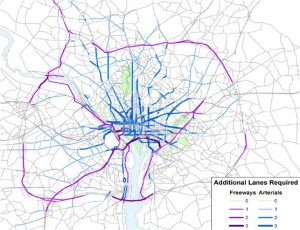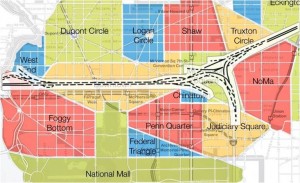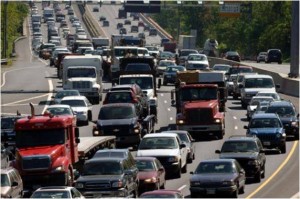What Does Transit Do For Regional Mobility?
One of the best ways to understand the value of something is to take it away, and measure the difference. So, as part of our “Business Case” for transit study, we tried taking away transit to see what happened to the Washington DC region, using MWCOG’s Regional Travel Demand Model. This model represents people’s origins and destinations, and all the different options for getting around, including detailed transit and highway capacity information. What does that model predict would happen without transit?
(Results shown here show the impact of all regional transit, including Metrorail, Metrobus, local/regional bus, MARC, and VRE services. Metro represents about three-quarters of regional passenger-miles traveled).
No Additional Roads: First, we looked at what would happen if everyone were able to respond to the loss of transit by choosing different destinations and travel patterns. That is, transit is removed, no new roads are built, but people are allowed to choose to work and shop at different locations as a result of changing congestion. In modeling terminology, we allowed the trip table to change. As a result:
- Vehicle-miles traveled would increase by 7-8%
- Congestion would increase by 25% across the region. Some people would notice little change in their commute, but some would spend a lot more time sitting in traffic – but on average, travelers would spend 25% more time in congestion.
- The added time and fuel wasted in congestion would cost travelers over $1.5 billion annually
- Traffic worsens so that residents make many fewer trips across county and state boundaries, indicating that our regional economy becomes fragmented:
- Workers have fewer job opportunities to choose from because many are too far from home. Employers have a smaller pool of employees to choose from.
- More trips stay local. For example, trips from Maryland and Virginia to DC drop 5-11%, and trips between Maryland and Virginia in the Compact area drop by 12-19%
- We fracture into several smaller regional economies, and lose the competitiveness of our regional economy
The scenario shows that Metro plays a critical role in keeping the region moving forward. Beyond diverting 7-8% of vehicle-miles traveled off the road, transit’s impact on congestion in Washington is several times greater than its current mode share. Transit carries significant number of people at exactly the times and places when our roads are at capacity. Our region’s roads are so congested that even a little bit more traffic can cause instability and slow everyone down. Transit benefits many in the region, even those who have never set foot in a bus or train.

Additional roads that would be required without transit in the Washington region. Thicker lines indicate number of lanes required. Total pavement required would be roughly the equivalent of two additional Capital Beltways.
Build Additional Roads: Second, we looked at how much additional road and parking infrastructure we would need to handle the additional traffic if transit were not available. In the model, we turned off transit, held travel patterns constant, and added lanes to each and every road in our network until every segment regained today’s levels of congestion. The results:
- The region would need over 1,000 lane-miles of new pavement, on freeways and arterial roads
- The equivalent of two additional Capital Beltways
- Potomac and Anacostia River bridges would need 4-6 additional lanes each
- Significant new road capacity would be required where expansion would be expensive and/or controversial, e.g. Constitution Avenue NW.
- The cost to build the roads, excluding the cost of land, would total $6.7 billion (this number assumes greenfield construction costs, and excludes public and private operating costs)
- We would need 200,000 additional parking spaces in the D.C. and Arlington core
- The equivalent of 166 city blocks of five-story parking garages
- At a cost of $4.1 billion
These findings put Metro’s role in context – two Beltways’ worth of pavement, and blocks and blocks of parking downtown are a visual representation of Metro’s impact on the city.

Plans in the 1960s and 70s called for a highway through downtown Washington. Map adapted from “District of Columbia Interstate System 1971,” November 1971, De Leuw, Cather Associates and Harry Weese & Associates, Ltd.
“But That Would Never Happen!” Imagining a Washington without public transit is, of course, a hypothetical situation. Without transit, Washington would look very different than it does today. Land use patterns would be different. But to understand transit’s role in the region today, we must compare it to some other alternative – a counterfactual is a key part of economic impact analysis. Predicting the effects of removing public transit is a good way to understand the role that transit plays today, and helps inform future planning.
Also, the idea of a Washington blanketed with significant parking and highways may not be so far-fetched. Many American cities are home to substantial parking lots and highways today. In the 1960s and 70s, plans called for major highways through downtown Washington, such as the one at right.
In the end: While transit has helped us avoid auto congestion, roads, and parking, it has also had other impacts as well. Transit has helped keep Washington moving and growing in a way that avoids significant roadway and parking infrastructure, has preserved valuable land for economic development, and has allowed our region to expand and compete as a single, connected economy.
Read the study’s Final Report (pdf).
Cross-posted at Region Forward.



Hi guys. I just found the blog and this is interesting stuff. I’m a Ph.D. candidate in Economics at Georgetown and have been working with issues related to public transportation. In particular, I did a study working with a local non-profit which was a randomized-control trial, testing whether providing free SmarTrip cards to individuals looking for low-wage jobs helped them find jobs faster, get better jobs, etc. It turned out to be a big help to them. If that’s useful to you at all in discussing the benefits of WMATA, let me know and I can send you a copy.